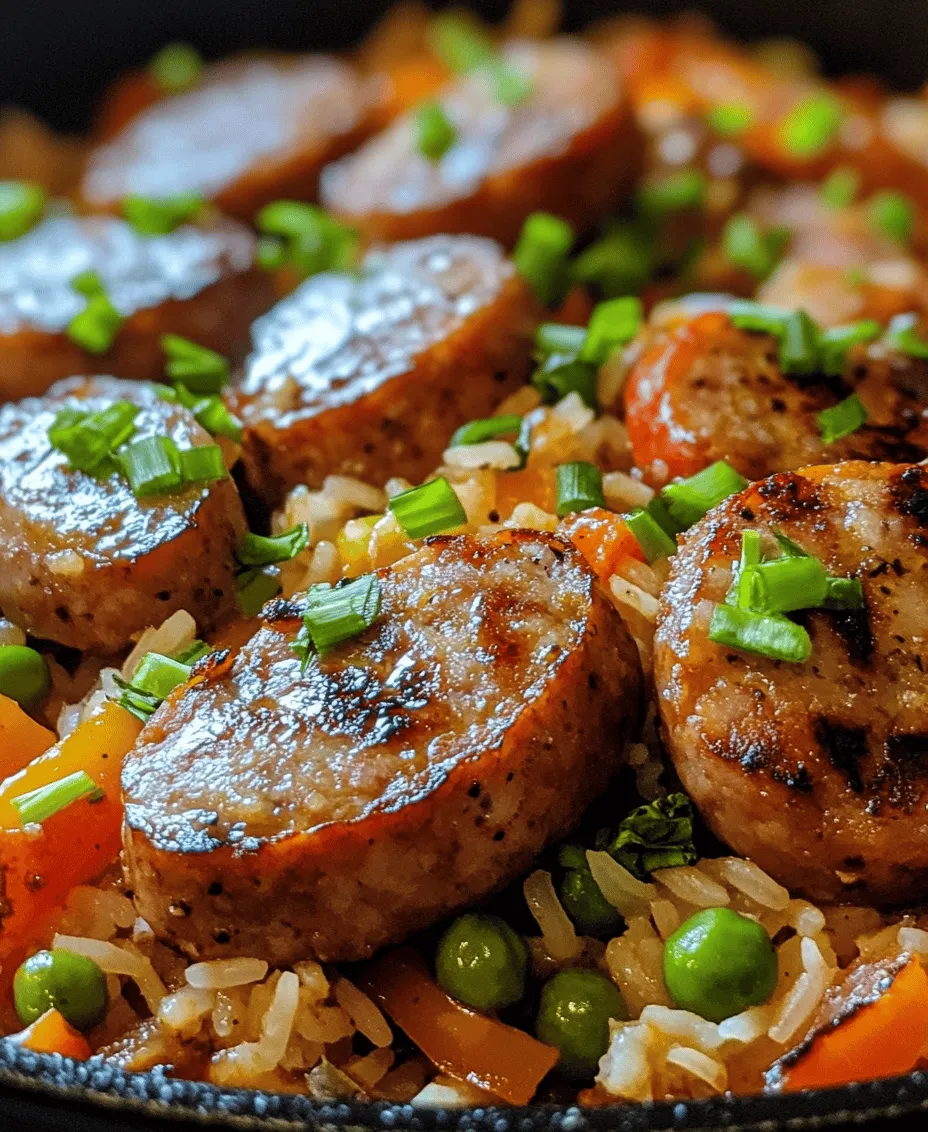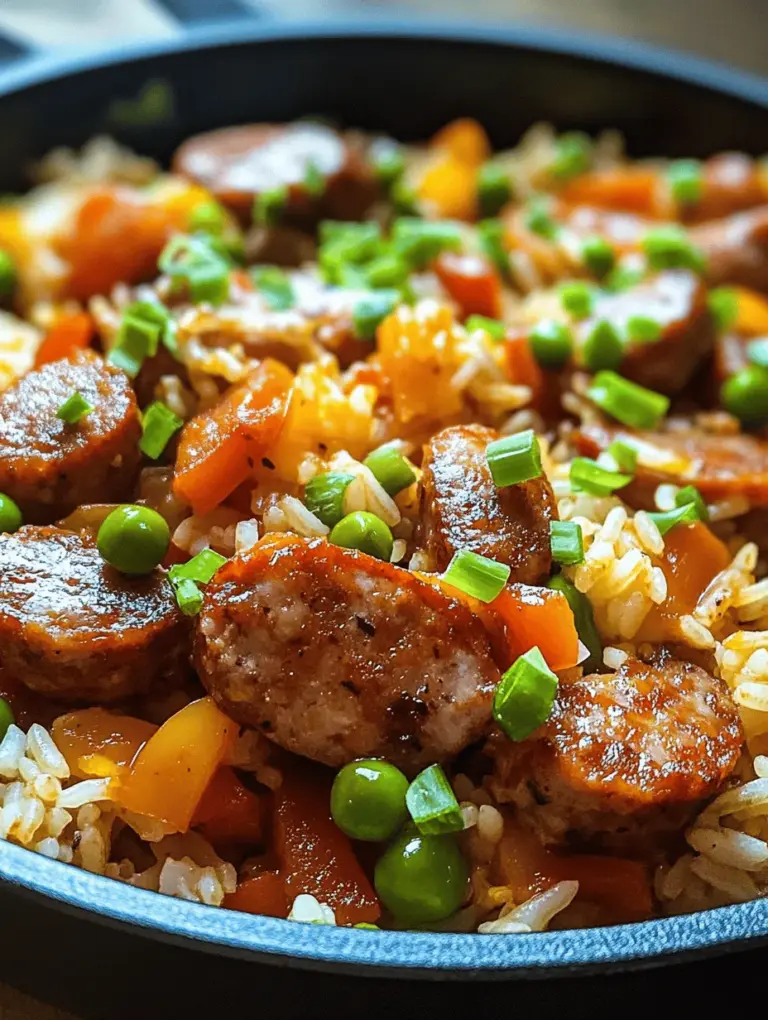Introduction
Cajun cuisine is a celebration of vibrant flavors and hearty ingredients, deeply rooted in the rich cultural tapestry of Louisiana. Its origins can be traced back to the Acadian French settlers who brought their culinary traditions to the bayou, blending them with local ingredients and African, Spanish, and Native American influences. This unique fusion has given rise to a cuisine that is bold, spicy, and incredibly satisfying. Among the many treasures of Cajun cooking, the Cajun Sausage and Rice Skillet stands out as a quintessential dish that encapsulates the heart of this culinary tradition.
This one-pan meal is not only a feast for the senses but also an embodiment of convenience. With its combination of savory sausage, aromatic vegetables, and fluffy rice, this dish is perfect for busy weeknights or family gatherings. The ease of preparation and the quick cooking time make it an ideal choice for anyone looking to enjoy a delicious home-cooked meal without spending hours in the kitchen. Whether you’re a seasoned chef or a novice cook, this Cajun Sausage and Rice Skillet is sure to impress!
The Essence of Cajun Cooking
To truly appreciate the Cajun Sausage and Rice Skillet, we must first understand the essence of Cajun cooking. This culinary style is rooted in the history and culture of Louisiana, where food is not just sustenance, but a way of life. Cajun cooking is characterized by its use of fresh, locally-sourced ingredients and bold flavors, often enhanced by a variety of spices and seasonings.
Key ingredients commonly found in Cajun dishes include rice, seafood, meats, and an array of vegetables. The foundation of many Cajun recipes is the “holy trinity” of vegetables—onion, bell pepper, and celery—which provides a flavorful base for countless dishes. Spices play a crucial role in Cajun cooking, with blends like cayenne pepper, garlic powder, and paprika adding depth and heat to the food.
The cultural significance of Cajun cuisine extends beyond the plate. It reflects the history of the region and the resilience of its people. Festivals, family gatherings, and communal meals are often centered around food, showcasing the rich flavors and traditions that define Cajun cooking. The Cajun Sausage and Rice Skillet is more than just a meal; it is a connection to the heritage and vibrancy of Louisiana life.
Ingredients Breakdown
A standout feature of the Cajun Sausage and Rice Skillet is its diverse array of ingredients, each contributing to the dish’s flavor profile and overall appeal. Let’s break down the key components:
Cajun Sausage
At the heart of this dish is the Cajun sausage, which adds a robust flavor and a hint of spice. Traditional Cajun sausage is often made from pork and is seasoned with a blend of spices that may include garlic, black pepper, and cayenne. There are several types of Cajun sausage available, including andouille and tasso.
– Andouille sausage is a smoked sausage that is coarsely ground, offering a bold, smoky flavor that is characteristic of Cajun dishes.
– Tasso is a spiced and smoked pork shoulder, which provides a more intense flavor and is often used in smaller quantities for seasoning.
For those who prefer a healthier option or are looking for alternatives, turkey sausage or chicken sausage can be used without sacrificing flavor.
Long-Grain White Rice
Long-grain white rice is the choice for this dish due to its cooking properties. This type of rice remains fluffy and separate when cooked, making it ideal for absorbing the rich flavors of the sausage and spices. It also cooks relatively quickly, making it a convenient option for weeknight dinners.
Fresh Vegetables
The addition of fresh vegetables elevates the flavor and nutrition of the Cajun Sausage and Rice Skillet.
– Onion, bell pepper, and garlic are essential in Cajun cooking, providing a savory base that enhances every bite.
– The onion adds sweetness and depth, while the bell pepper introduces a slight crunch and a hint of sweetness.
– Garlic infuses the dish with a fragrant aroma and a robust flavor.
Diced Tomatoes
Diced tomatoes play a vital role in contributing moisture and texture to the dish. They help to create a rich sauce that clings to the rice and sausage, ensuring every bite is packed with flavor. The acidity of the tomatoes also balances the richness of the sausage, creating a harmonious blend of tastes.
Chicken Broth
Using quality chicken broth is crucial for depth of flavor. It serves as the cooking liquid for the rice, allowing it to absorb additional flavors as it cooks. Homemade broth is always a great option, but store-bought varieties can also be used for convenience. Look for low-sodium options to control the salt content of the dish.
Cajun Seasoning and Paprika
Cajun seasoning is a must-have for this recipe, as it brings the authentic taste of Louisiana right into your kitchen. This seasoning blend typically includes a mix of spices like garlic powder, onion powder, cayenne pepper, and paprika.
– Paprika adds a subtle sweetness and a beautiful red color to the dish, enhancing its visual appeal and flavor profile.
Frozen Peas
Frozen peas are often added to the skillet towards the end of cooking. They are not only a nutritious addition but also provide a pop of color that brightens the dish. Peas are a good source of vitamins and minerals, making this dish even more balanced.
Olive Oil
Finally, olive oil is used for sautéing the sausage and vegetables. This healthy fat not only aids in cooking but also adds a layer of richness to the dish. Opt for extra virgin olive oil for the best flavor and health benefits, as it is rich in antioxidants and healthy monounsaturated fats.
Step-by-Step Cooking Instructions
Now that we’ve explored the key ingredients, it’s time to dive into the cooking process. Proper preparation is essential for efficiency and success in the kitchen. Here’s how to get started:
Preparing Your Ingredients
Before you begin cooking, it’s important to prepare all your ingredients. This step will save you time and ensure a smoother cooking experience.
1. Chop the Vegetables: Dice the onion, bell pepper, and garlic. Having them prepped and ready to go will allow you to focus on cooking without interruption.
2. Slice the Sausage: If using andouille or another type of Cajun sausage, slice it into bite-sized rounds. This will help it cook evenly and allow for better distribution of flavor throughout the dish.
3. Measure Your Rice: Rinse the long-grain white rice under cold water to remove excess starch, which can make the rice gummy. Drain and set aside.
Sautéing the Sausage
With your ingredients prepped, it’s time to start cooking.
1. Heat the Olive Oil: In a large skillet over medium heat, drizzle a couple of tablespoons of olive oil. Allow it to heat until shimmering but not smoking.
2. Brown the Sausage: Add the sliced Cajun sausage to the skillet. Sauté for about 5-7 minutes, turning occasionally, until the sausage is nicely browned and has released its flavorful oils. This browning process enhances the overall taste of the dish, creating a savory base.
3. Add the Vegetables: Once the sausage is browned, add the chopped onion, bell pepper, and garlic to the skillet. Sauté for another 3-4 minutes, until the vegetables begin to soften and become fragrant. Stir frequently to prevent burning and ensure even cooking.
This initial phase of cooking is crucial, as it lays the foundation for the rich flavors that will develop throughout the dish. By browning the sausage and sautéing the vegetables together, you create a flavor-packed base that will elevate the entire meal.
The journey to a delicious Cajun Sausage and Rice Skillet has just begun. With your ingredients prepared and the sausage and vegetables sautéed to perfection, you are well on your way to creating a comforting and flavorful dish that embodies the spirit of Cajun cuisine. Stay tuned as we continue with the next steps in this culinary adventure!

Adding Vegetables: How to Properly Sauté for Maximum Flavor
To elevate your Cajun Sausage and Rice Skillet, the first step is incorporating fresh vegetables. The key to maximizing flavor lies in the sautéing technique. Start by selecting a blend of bell peppers, onions, and celery—often referred to as the “Holy Trinity” in Cajun cooking.
Sautéing Steps:
1. Heat the Skillet: Place your skillet over medium heat and add a drizzle of olive oil or a pat of butter. Allow it to heat until shimmering, which will help in achieving a good sear on the vegetables.
2. Add Aromatics: Begin by adding diced onions and sauté them until they become translucent, about 3-4 minutes. This step builds a flavor base.
3. Incorporate Other Vegetables: Next, add chopped bell peppers and celery, cooking for an additional 4-5 minutes. Stir occasionally to prevent sticking and ensure even cooking. The goal is to soften the vegetables while allowing their natural sugars to caramelize slightly, enhancing the dish’s overall taste.
Incorporating Rice and Spices: Techniques for Flavor Absorption
Once your vegetables are perfectly sautéed, it’s time to introduce the rice and spices, which are crucial for flavor absorption.
Choosing the Right Rice:
Use long-grain white rice or jasmine rice for this recipe, as these varieties will absorb the flavors beautifully without becoming mushy.
Flavoring Techniques:
1. Add the Rice: Stir in the uncooked rice, allowing it to toast slightly in the hot skillet for about 1-2 minutes. This will give the rice a nutty flavor and help it absorb the spices better.
2. Season Generously: Sprinkle in Cajun seasoning—typically a mixture of paprika, cayenne pepper, garlic powder, onion powder, and oregano. Adjust the amount to your heat preference. Stir well to coat the rice evenly with the spices, ensuring every grain is flavored.
Combining with Liquids: Tips for Achieving Perfect Consistency
The next step is to add the liquids, which will help cook the rice and infuse it with all the flavors from the sausage and vegetables.
Liquid Ratio:
For every cup of rice, add approximately 1.5 to 2 cups of broth (chicken broth is recommended for a richer flavor) depending on your desired consistency.
Technique for Combining:
1. Pour the Broth: Gently pour in the broth, followed by a splash of hot sauce for an extra kick.
2. Stir and Scrape: Use a wooden spoon to scrape the bottom of the skillet, making sure to release any flavorful bits that may have stuck while sautéing.
3. Bring to a Boil: Increase the heat to high until the mixture begins to boil, then reduce it back to low.
Simmering to Perfection: Understanding the Role of Simmering
Simmering is a crucial step in cooking rice, allowing it to absorb the flavors and moisture without becoming overcooked.
1. Cover the Skillet: Place a lid on the skillet and allow it to simmer for about 18-20 minutes. This process will cook the rice evenly and lock in the flavors.
2. Check for Doneness: After the cooking time, lift the lid and check the rice. It should be tender and have absorbed most of the liquid. If it’s still al dente, cover and let it steam for a few more minutes.
Final Touches: Seasoning and Timing for Peas
As your dish nears completion, it’s essential to add the final touches to ensure the flavors are balanced.
1. Season to Taste: Remove the skillet from heat and taste; adjust seasoning with more Cajun seasoning or salt as needed.
2. Add Peas: Fold in frozen peas during the last 5 minutes of cooking or right after you remove the skillet from heat. The residual heat will cook the peas just enough to retain their bright color and slight crunch.
Serving Suggestions: Ideas for Visual Appeal
Presentation can elevate your dish from simple to spectacular. Consider these serving suggestions:
– Garnish with Fresh Herbs: Sprinkle chopped parsley or green onions on top to add a pop of color and freshness.
– Serve with a Side: Accompany the dish with crusty bread or cornbread to soak up any remaining juices.
– Add a Squeeze of Lemon: A drizzle of fresh lemon juice can brighten the dish and enhance the flavors of the sausage and spices.
Nutritional Information
Caloric Breakdown:
– Each serving of Cajun Sausage and Rice Skillet contains approximately 450-550 calories, depending on portion sizes and specific ingredients used.
Nutritional Benefits:
– Protein: The sausage provides a good source of protein, essential for muscle repair and overall health.
– Fiber: The addition of vegetables and peas contributes dietary fiber, promoting digestive health.
– Vitamins and Minerals: Bell peppers and peas are rich in vitamins A and C, antioxidants that support the immune system.
Dietary Considerations:
– This dish can be adapted to be gluten-free by ensuring your sausage is gluten-free and using compliant broth.
– It is also high in protein, making it suitable for those looking to maintain or build muscle mass.
Variations and Customizations
Ingredient Substitutions:
– Swap out the sausage for turkey sausage or chicken for a leaner option. For a vegetarian twist, consider using plant-based sausage or omitting the meat altogether and adding extra beans.
– Enhance the vegetable content by adding zucchini, corn, or spinach for additional nutrients and flavors.
Dietary Variations:
– For a vegetarian version, replace sausage with black beans or lentils, and add more vegetables for texture and flavor.
– To spice it up further, consider adding diced jalapeños or a dash of cayenne pepper for those who enjoy an extra fiery kick.
Storage and Reheating Tips
Best Practices for Storing Leftovers:
– Allow the Cajun Sausage and Rice Skillet to cool completely before transferring it to an airtight container. It can be stored in the refrigerator for up to 3-4 days.
– For longer storage, consider freezing portions in freezer-safe bags for up to 3 months.
Recommendations for Reheating:
– To reheat, add a splash of broth or water to the skillet to prevent drying out and heat over medium-low heat, stirring occasionally.
– Alternatively, you can use a microwave, reheating in 30-second intervals to avoid overheating.
Conclusion
The Cajun Sausage and Rice Skillet is a delightful and hearty meal that combines the rich flavors of Cajun cuisine with the ease of a one-pan recipe. This dish is not only simple to prepare but also incredibly versatile, allowing for a range of customizations to suit different tastes and dietary needs.
From the aromatic vegetables to the perfectly cooked rice infused with spices, each bite transports you to the heart of Louisiana. Whether you’re a seasoned cook or a kitchen novice, this dish is sure to impress and satisfy a wide range of palates. Embrace the joys of Cajun cooking and explore the wonderful flavors it has to offer!

